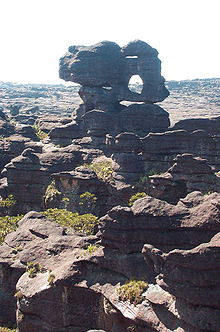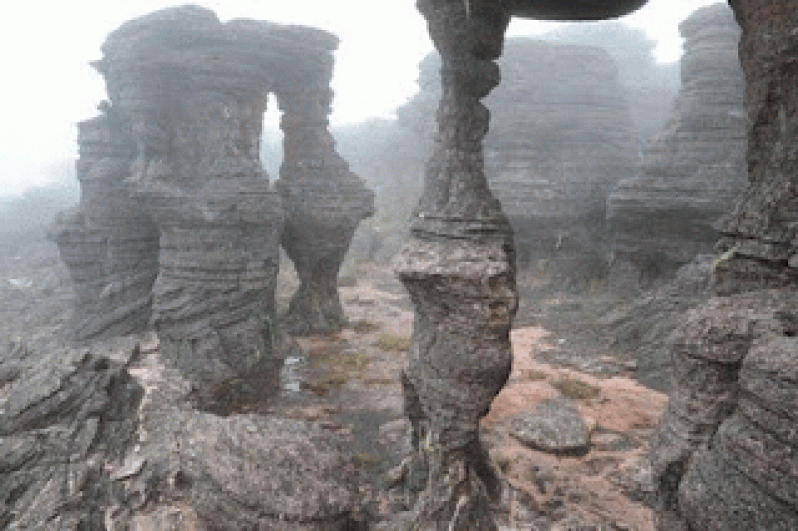The Lost World, as seen through the eyes of an explorer
THE TEPUIS, the majestic Kaieteur Falls, Orinduik Falls, the entire Roraima Group in the Northern Province, is a geological highlight.  But there are some very special places that are of outstanding natural beauty and importance, even in such an interesting area of Guyana.
But there are some very special places that are of outstanding natural beauty and importance, even in such an interesting area of Guyana.
In 1912, the Scottish author Sir Arthur Conan Doyle released a novel named The Lost World.
The Lost World was a story concerning an expedition to a mysterious flat mountain plateau in the Amazon Basin of South America, inhabited by cannibalistic natives, dinosaurs, carnivorous plants, prehistoric animals, and giant spiders. The book, like many others by the literary genius who created the fictional character Sherlock Holmes, was vastly entertaining.
Sir Conan Doyle disclosed that his masterpiece on the unbelievably weird Lost World had been inspired by a report on Mount Roraima written by the late 19th century South American researcher Sir Robert Schomburgk.
Ever since 1838, expedition after expedition had reached the base of the mighty Roraima, but all had failed to find a way up the towering cliff sides to the lofty mountain summit. Just after all hope had been abandoned, the chance discovery of a remote ledge in the towering cliffsides allowed one last effort to be made to conquer the mountain and discover the lost world.
On December 14th, 1884, Everard Im Thurn battled up the ledge and finally reached the summit, stepping into a land that had never before been seen by mankind. When he reached the summit of Roraima, it was as if he stepped onto another planet. Practically everything he saw was new to science, and he returned with hundreds of plant and animal specimens, representing a wealth of new discoveries!
December 14th 2011 marked the 127th anniversary of the first ascent of Mount Roraima, Guyana’s and South America’s Lost World.
The following is an excerpt from the book: “The first ascent of Mount Roraima,” written by another 19th century explorer in Guyana (then British Guiana), Sir Everard Ferdinand Im Thurn (1852 – October 9, 1932).
Sir Im Thurn wrote: “Up this part of the slope we made our way with comparative ease, till we reached a point where one  step more would bring our eyes on a level with the top — and we should see what had never been seen since the world began, should see that of which, if it cannot be said all the world has wondered, at least many people have long and earnestly wondered; should see that of which all the few white men or red, whose eyes had ever rested on the mountain, had declared would never be seen while the world lasts — should learn what is on top of Roraima.
step more would bring our eyes on a level with the top — and we should see what had never been seen since the world began, should see that of which, if it cannot be said all the world has wondered, at least many people have long and earnestly wondered; should see that of which all the few white men or red, whose eyes had ever rested on the mountain, had declared would never be seen while the world lasts — should learn what is on top of Roraima.
“Then the step was taken and we saw, surely, as strange a sight — regarded simply as a product of nature — as may be seen in this world; nay, it would probably not be rash to assert that very few sights even as strange can be seen.
“The first impression was one of inability mentally to grasp such surroundings; the next that one was entering on some strange country of nightmares, for which an appropriate and wildly fantastic landscape had been formed; some dreadful and stormy day, when, in their mid-career, the broken and chaotic clouds had been stiffened in a single instant into stone. For all around were rocks and pinnacles of rocks of seemingly impossibly fantastic forms, standing in apparently impossibly fantastic ways — nay, placed one on, or next to, the other in positions seeming to defy every law of gravity — rocks in groups, rocks standing singly, rocks in terraces, rocks as columns, rocks as walls and rocks as pyramids, rocks ridiculous at every point with countless apparent caricatures of the faces and forms of men and animals, apparent caricatures of umbrellas, tortoises, churches, canons, and of innumerable other most incongruous and unexpected objects.
“And between the rocks were level spaces, never of great extent, of pure yellow sand, with streamlets and little waterfalls and pools and shallow lakelets of pure water; and in some places there were little marshes filled with low, scanty and bristling vegetation. And here and there, alike on level space and jutting from some crevice in the rock, were small shrubs in form like miniature trees, but all apparently of one species. Not a tree was there; no animal life was visible or, it even seemed, ever lived there. So intensely quiet and undisturbed did the place look as if that state ever had been there. Look where one would on every side, it was the same; and climb what high rock one liked, in every direction, as far as the eye could see, was this same wildly extraordinary scenery.”
That was in 1884.
There is no information to suggest that anything much has changed since then.
Earth matters…
SHARE THIS ARTICLE :
Facebook
Twitter
WhatsApp



.jpg)









